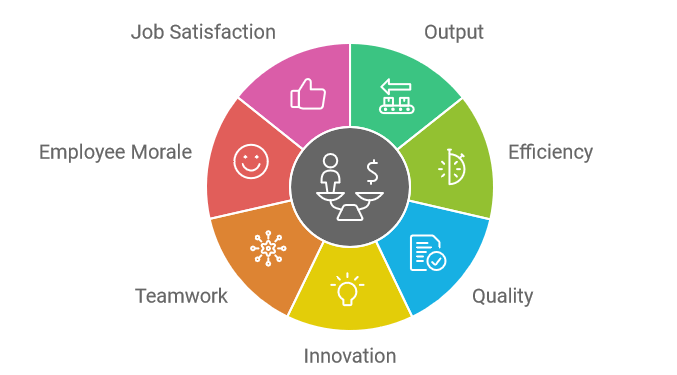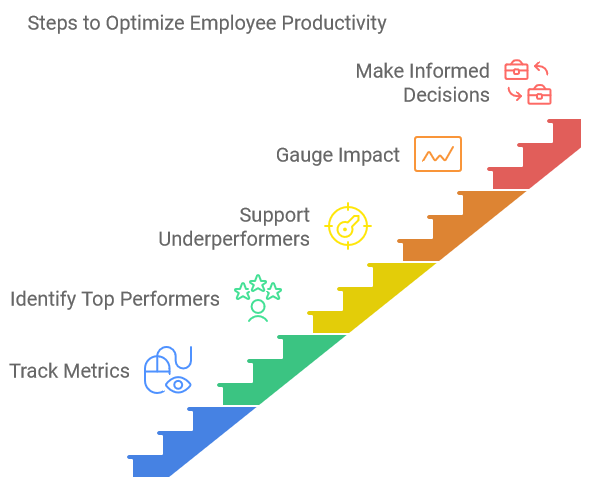
- Introduction: Understanding Productivity
- Key Components of Productivity
- The Importance of Productivity in Different Contexts
- Metrics to Measure Productivity
- Tools and Techniques for Improving Productivity
- Challenges to Achieving High Productivity
- The Role of Motivation and Mindset in Productivity
- Conclusion
Introduction: Understanding Productivity
In today’s fast-paced world, productivity is crucial for success, whether in the workplace, managing a business, or in personal life. But what exactly is productivity? At its core, productivity refers to the efficiency with which tasks and goals are accomplished. It is about maximizing output while minimizing wasted time and resources. Measuring productivity can be done by tracking the ratio of output to input, whether that’s the completion of tasks in a workday, sales growth, or personal achievements. To improve productivity during Data Science Training, one must first understand the key components time management, focus, and resource allocation. Effective tools like task managers, project management software, and time trackers can help individuals stay on top of their goals. Additionally, techniques like the Pomodoro method, prioritization, and setting clear deadlines can boost efficiency. However, improving productivity comes with challenges, such as managing distractions and overcoming procrastination. It’s important to recognize that being constantly productive can also lead to burnout if not balanced properly. In this blog, we’ll dive into practical strategies to enhance productivity while maintaining a healthy work-life balance in a demanding world.
Interested in Obtaining Your Data Science Certificate? View The Data Science Course Training Offered By ACTE Right Now!
Key Components of Productivity
To truly understand productivity, it’s essential to break it down into its core components. These include efficiency vs. effectiveness, time management, and resource utilization. Efficiency is about doing things in the most cost-effective way, maximizing output while minimizing input, time, and effort key among the Necessary Skills for a Successful Career in Data Science. Effectiveness, on the other hand, is about doing the right things to achieve the desired outcomes, ensuring the right tasks are prioritized and completed, even if they take more time. Time management is another crucial element, as it involves prioritizing tasks, setting clear goals, and using time effectively to avoid distractions and meet deadlines.

Those who manage their time well tend to be more productive, as they stay focused and accomplish their goals efficiently. Finally, resource utilization is about maximizing available resources whether human, technological, or financial to boost productivity without increasing costs. In both business and personal settings, optimizing resource use, whether through delegation, automation, or utilizing tools, allows individuals and organizations to get more done with less effort, driving greater overall productivity.
The Importance of Productivity in Different Contexts
- Government and Public Services: Increased productivity in public sectors means faster service delivery, better policy implementation, and optimal use of taxpayer money.
- Business Growth: For businesses, increased productivity leads to better use of resources, higher output, and improved customer satisfaction. It allows companies to scale operations and innovate while maintaining quality.
- Personal Development: On an individual level, being productive helps achieve personal goals, reduces stress, and builds a sense of accomplishment. It enhances time management and self-discipline, leading to overall life satisfaction.
- Education: Productivity helps maximize learning, especially with topics like How to Use IF ELSE Statements in Python.
- Healthcare: Productivity in healthcare ensures timely patient care, optimized use of medical resources, and better health outcomes. Efficient workflows help reduce wait times and enhance service quality.
- Remote Work: In remote work environments, productivity is vital for maintaining accountability, collaboration, and output. Digital tools and clear communication play a key role in sustaining productivity outside traditional office settings.
- Workplace Efficiency: In professional environments, productivity directly impacts performance, profitability, and competitiveness. High productivity enables teams to meet deadlines, deliver quality work, and reduce operational costs.
- Output per Hour: This metric calculates the amount of work or output produced per hour worked. It’s widely used in both individual and organizational contexts to assess efficiency.
- Task Completion Rate: Measuring how many tasks are completed within a specific time frame helps gauge productivity and whether work is being finished as planned.
- Time Spent on Tasks: Tracking task time reveals inefficiencies in Data Science vs Data Analytics vs Machine Learning .
- Utilization Rate: Common in service-based industries, this measures the percentage of available working time that is actually spent on productive work versus idle time.
- Goal Achievement Rate: This measures how many set goals or key performance indicators (KPIs) are achieved within a defined period, helping to assess overall effectiveness.
- Quality of Work: Productivity isn’t just about quantity tracking error rates, customer satisfaction, or rework needed provides insight into the quality of output.
- Revenue per Employee: A financial productivity metric, this measures how much revenue each employee generates, indicating workforce efficiency.
- Employee Engagement: Engaged employees tend to be more productive. Regular surveys and feedback tools can help measure engagement levels and their impact on performance.
- Burnout and Stress: High workloads without adequate breaks or support can lead to burnout, negatively impacting both mental health and productivity in the long term.
- Poor Time Management: Without proper planning or prioritization, individuals and teams may spend too much time on low-value tasks, leading to missed deadlines and inefficiencies.
- Distractions and Interruptions: Constant notifications, emails, and unplanned meetings can disrupt focus and significantly reduce productivity, especially in open or remote work environments.
- Lack of Clear Goals: When objectives are vague or constantly changing, employees struggle to stay aligned and motivated. Clear, measurable goals are essential for productive work, especially in What is Data Scrubbing.
- Ineffective Communication: Miscommunication or lack of information can lead to repeated work, confusion, and delays. Efficient communication channels and clarity are key to maintaining productivity.
- Inadequate Tools and Resources: Outdated systems or lack of access to the right tools can hinder performance. Investing in appropriate technology and support improves workflow and efficiency.
- Resistance to Change: Employees or teams may resist new processes, tools, or methods intended to improve productivity, slowing down progress. Proper training and change management are vital to overcoming this barrier.
To Earn Your Data Science Certification, Gain Insights From Leading Data Science Experts And Advance Your Career With ACTE’s Data Science Course Training Today!
Metrics to Measure Productivity

Tools and Techniques for Improving Productivity
There are various tools and techniques available to help individuals and teams improve productivity, each designed to streamline processes and enhance efficiency. Time-tracking tools such as Toggl, Harvest, and RescueTime are great for monitoring how time is spent throughout the day. These tools help identify time-wasters, track productivity patterns, and ensure that time is used effectively. Productivity apps like Trello, Asana, and Notion are popular choices for organizing tasks, setting deadlines, and tracking progress. These apps provide an easy-to-use platform to manage projects, collaborate with teams, and stay on top of goals during Data Science Training. They offer features like task assignments, progress tracking, and reminders that help individuals stay focused and productive. Another powerful set of techniques comes from Lean and Six Sigma methodologies, which focus on process improvement by reducing waste and improving quality. Lean emphasizes creating more value with fewer resources, while Six Sigma aims to eliminate defects and inefficiencies. By applying these methods, organizations can streamline operations, enhance product or service quality, and ultimately boost productivity across teams. These tools and techniques, when implemented effectively, can significantly optimize both personal and organizational productivity.
Are You Considering Pursuing a Master’s Degree in Data Science? Enroll in the Data Science Masters Course Today!
Challenges to Achieving High Productivity
The Role of Motivation and Mindset in Productivity
Motivation and mindset are crucial factors in boosting productivity. A motivated individual is more likely to approach tasks with energy and focus, making it easier to stay on track and complete work efficiently. Motivation fuels persistence, helping individuals push through challenges and setbacks. A positive mindset is equally important, fostering resilience, reducing stress, and enhancing overall well-being. A positive attitude allows individuals to view challenges as opportunities for growth rather than obstacles, which is key in a Data Analyst Job Description Setting clear, achievable goals provides direction and helps measure progress, ensuring that efforts are aligned with desired outcomes. Additionally, finding purpose in work is key. It fosters a more profound sense of fulfillment and commitment, making tasks more meaningful. When individuals see the bigger picture and understand how their work contributes to personal and professional growth, they are more likely to stay motivated and productive. Motivation, mindset, and purpose are foundational to long-term success and productivity.
Preparing for a Data Science Job Interview? Check Out Our Blog on Data Science Interview Questions & Answer
Conclusion
Productivity isn’t about working harder or longer but about working smarter. It involves using time and resources effectively to deliver meaningful results. Understanding and measuring productivity is key to achieving success in a business, personal, or societal context. Tracking key metrics helps identify areas for improvement while applying productivity-enhancing tools can streamline processes and increase efficiency. Cultivating the right mindset, such as focusing on clear goals and maintaining a positive attitude, is equally important for driving productivity during Data Science Training. By aligning efforts with purpose and direction, both individuals and organizations can boost their performance. However, it’s essential to balance productivity with well-being to avoid burnout. Sustainable success depends on maintaining a healthy work-life balance, ensuring that high productivity doesn’t compromise mental or physical health. Prioritizing well-being alongside productivity leads to long-term success, allowing individuals and organizations to achieve their goals without sacrificing their overall health and happiness.


